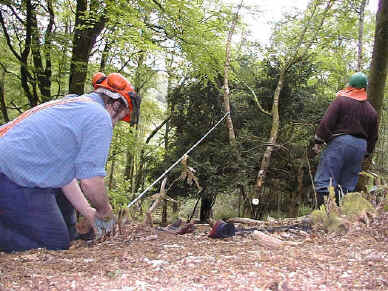Woodland Project Phase 2 Survey Report
| 12. Trees, particularly poorly developed Silver Birch, have been thinned out to improve the quality of the remaining specimens (Plate 5). This has resulted in a lowering of the density of Silver Birch trees. Remaining specimens also have a greater mean girth. |
|
Plate 5. Thinning out the trees on the Project site |
| 13. Cleared Rhododendron regenerated very rapidly, particularly in areas
which had previously been densely covered. In one of the 20m quadrats, regenerating
Rhododendron covered 58% of the area. The regenerating Rhododendron has now been treated
with Roundup, a biodegradable herbicide. 14. Seedlings occurred in surprisingly high densities across most of the project site. The majority were seedlings of tree species already present on the site, but seedlings of species such as Foxglove, Bramble, Gorse, Ivy and Honeysuckle, were also present. It is likely that germination of seeds in the soil seed bank was promoted by removal of the leaf litter layer and the raking of the soil surface. 15. Area 4 showed little sign of regeneration. This is likely to be related to the fact that this was the last area to be raked. There has therefore been less time for germination and establishment of seedlings in this region. 16. There were other regional variations in regeneration across the project site. These included variations in species composition and individual species density. 17. Twelve species of bryophytes were found in this survey (an increase of two species from the initial survey). These were mostly confined to the pilot project area which has had longer to regenerate. In newly cleared areas mosses were found in very small quantities in the ground layer. The most widespread species were Hypnum cupressiforme, H. andoi and H. resupinatum. 18. Most of the mosses were species normally associated with woodlands and many were species characteristically associated with acid substrata. 19. A third survey to identify further changes to the vegetation on the Woodland Project site will be carried out in one years time. |
Woodland Project Phase 2 |
||
Results |
||
